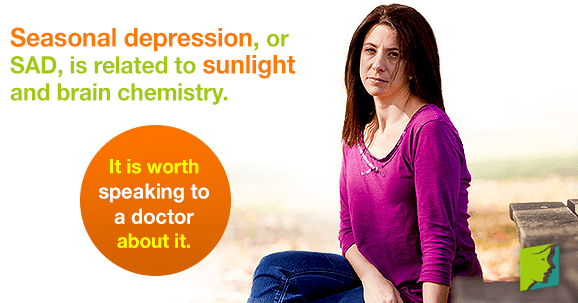Seasonal affective disorder (SAD) is a type of depression that is related to the seasons. In most people, SAD strikes in winter, so for this reason, this article will focus more on this type. However, it should be noted that there are rarer cases of people developing seasonal depression in the summer months. Read on to discover more about this disorder.
What Is Seasonal Depression?
Depression is a constant feeling of sadness or hopelessness that does not go away and makes it impossible for the sufferer to maintain a positive outlook on anything. People with SAD will notice the symptoms start and finish at around the same time every year - normally when the days become shorter and the temperature drops. SAD tends to affects more women than men, and in addition seems to be more prevalent in younger people, most notably those between the ages of 18 and 30.
For a person to be diagnosed with seasonal depression, they must exhibit the following:
- Depression and other symptoms for a minimum of two consecutive years during the same season
- Depression-free periods following episodes of depression
- Unexplained behavior and mood changes
Symptoms
Many of the symptoms of SAD are the same as those of people with regular depression, such as feelings of hopelessness, lack of motivation, and unexplained aches and pains, but there are some symptoms that are more specific to depression that are dependent on the seasons:
- Irritability
- Tiredness or low energy
- Problems getting along with other people
- Hypersensitivity to rejection
- Heavy, “leaden” feeling in the arms or legs
- Oversleeping
- A craving for foods high in carbohydrates
- Weight gain
What Are the Causes of Seasonal Depression?
Although there seems to be a strong correlation between lack of sunlight and onset of SAD, the exact causes of SAD are not fully understood. The production of melatonin and serotonin is believed to be affected by exposure to light, and these chemicals regulate sleep and mood. However, more research into this area needs to be carried out in order to reach any concrete conclusions.
Myths about Seasonal Depression
Although there is a lot of reliable information about seasonal depression, there are also some myths that prevail, including:
“A light lamp is the answer to seasonal depression”
Although some people find these to be helpful, the evidence behind them is weak. They are based on the theory that the light mimics daylight, producing the same chemical effects in the brain that would happen in the summer. This might be true, but in the current absence of solid data to back up the claims, they might be little more than an expensive gimmick.
“Suicide rates rise during winter”
Although widely believed, and attributed to a rise in depression because of the weather, this idea is actually false. In fact, a proper look at the statistics shows that suicide rates actually drop during the winter season and peak in the spring, and experts believe that the reason for this has absolutely nothing to do with the weather. Instead, it is thought that the social aspect of the Christmas holidays are the reason people are less likely to feel suicidal, whereas after Christmas, debts can be high and the social support network might disappear.
Seasonal depression is similar to depression except it occurs only at certain times of the year. Most people will find the depression will lift after the season comes to an end, but it is nevertheless worth speaking to a doctor in order to find out ways to deal with it. Read more about winter depression.
Sources
- Cleveland Clinic. (2013). Seasonal Depression. Retrieved October 23, 2014, from http://my.clevelandclinic.org/neurological_institute/center-for-behavorial-health/disease-conditions/hic-seasonal-depression.aspx
- National Health Service UK. (2013). Treating seasonal affective disorder. Retrieved October 23, 2014, from http://www.nhs.uk/Conditions/Seasonal-affective-disorder/Pages/Treatment.aspx
- NYU Langone Medical Center. (2014). True or False: Depression and Suicide Rates Rise During the Holiday Season. Retrieved October 23, 2014, from http://www.med.nyu.edu/content?ChunkIID=156980
- Sifferlin, A. (2014). Can Winter Really Make You Sick? The Truth About Seasonal Affective Disorder. Retrieved October 23, 2014, from http://time.com/278/can-winter-really-make-you-sick-the-truth-about-seasonal-affective-disorder/
- West Virginia University. (2014). Is It the Winter Blues or Seasonal Affective Disorder? Retrieved October 23, 2014, from http://well.wvu.edu/articles/is_it_the_winter_blues_or_seasonal_affective_disorder




